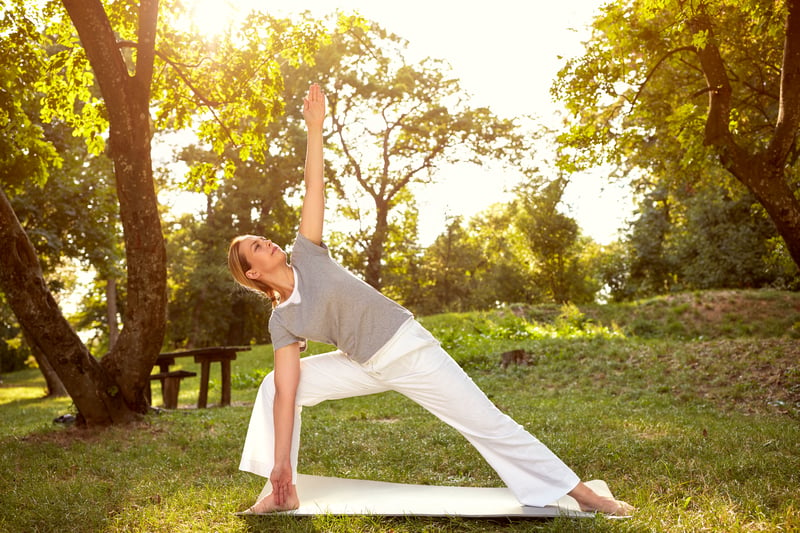The 7 Best Balance Exercises for Everyone Over 60

Exercising for better balance may not sound very sexy, and the best balance exercises may not be on the top of your priority list, but they should be, especially as those birthdays add up. Maintaining good posture, working on your flexibility, and exercising for better balance will all go a long way when it comes to optimal overall health and wellness long into the future.
What Is Balance?
Balance is comprised of many aspects including postural and equilibrium control. That is, balance is the ability to control both the movement of your body and the state of your body at rest. Your ability to move and not fall, as well as your ability to move into and maintain certain positions, can be compromised if you don’t work on your balance.
The Importance of Posture in Relation to Balance
Along with your ability to balance comes posture control. If you have bad posture, your body will automatically be misaligned, and that will make it so much more difficult to move without placing undue stress on your body. Being aligned and alleviating pressure, tension, and stress on your body is necessary to balance properly.
The Importance of Flexibility in Relation to Balance
Sometimes folks will have bad posture due to a lack of flexibility. You can imagine if your muscles are tight, it could potentially pull other muscles (and even bones) out of place over time. A misaligned frame with bad posture and inflexible, tight muscles will make it difficult to maintain your balance and will hinder your ability to move.
According to the Centers for Disease Control and Prevention, falls are a leading cause of injury, and even death, in Americans aged 65 and older. The Center says that seniors experience falls as often as once a second, with one out of five falls causing a need for hospitalization. Falls are dangerous for many reasons, among those reasons being broken bones and head injuries.
Falling can also cause a host of psychological issues as the person then fears living on their own, is afraid to move about, and is hesitant to engage in normal, everyday activities.
Try these 7 Best Balance Exercises
Maintaining good balance becomes all the more important as you continue to age. Regular exercise is important for maintaining not only muscular strength but bone strength as well. It’s a known fact that you lose muscle mass, bone mass, and strength over the years, and doing whatever you can to maintain and increase these should be a priority. In addition to a regular resistance training routine, it’s just plain smart to also incorporate some balance exercises into your program. Here are a few for you to try:
1. Foot Lifts
This exercise is a great starting point if you’re new to balance exercises or you’re recovering and rehabbing from injury. Begin by standing with your feet about hip-width apart. You can place your hands on your hips or your arms out to your sides, whatever feels good for you.
Lift your right knee so your foot is off the ground. Hold this position for a count of five and then return your leg to the starting position. Repeat on the opposite side. As you get better at balancing, you can hold this position longer.
2. Flamingo Stand
True to its moniker, the flamingo stand strives to emulate the effortlessness with which flamingos stand. Commonly seen on one leg, flamingos have the unique ability to balance for long periods of time on one leg while resting the opposite leg on the weight-bearing appendage.
Begin by standing with your hands on your hips. Slowly slide your right foot up the inner side of your left leg until it comes to about knee level. Hold this position for a count of five and then return your foot to the starting position by sliding it back down your leg. Repeat on the opposite side.
3. Tightrope Walk
You may want to start this balance exercise relatively close to a wall so you can gradually work on your balance over time. Begin by standing up straight with your left side near a wall and your feet next to each other, pointing straight ahead.
With your hand lightly supporting you on the wall, place your right foot directly in front of your left foot (you’ll be walking toe to heel). Next, place your left foot directly in front of your right foot, with your left heel directly in front of the toes of your right foot.
Continue this “tightrope” walk for the length of the wall. Then go back in the opposite direction using your right hand to support you. Over time, you should be able to do this walk without the support of the wall.
4. Grapevine Walk
Graduate to this walk once you have fully mastered the tightrope walk. You’ll start in a similar position standing straight with your hands on your hips and your feet together.
Lift your right leg and place your foot in front of and to the left of your left foot so your legs cross over each other. Bend your knees slightly as you take this step forward. Next, while maintaining balance on your right foot and leg, bend your knees slightly, lift your left foot and place it over, in front of, and slightly to the right of your right foot.
You’ll almost be forming figure 8s as you walk. Take your time to regain your balance in between steps.
5. Chair Squats
Stand in front of a stable chair, facing away from it. With your arms outstretched directly in front of you and parallel to the ground, and your feet about hip-width apart, push your hips backwards as you bend at the knees.
Keep bending at the knees while kicking your hips back until your butt hits the seat. Maintain an upright chest during this exercise and keep your head up and looking straight ahead.
Once you touch the seat, push upwards using your leg and glute muscles to return to a standing position. Repeat this balance exercise 5 – 10 times.
6. Spine Mobility
Start on a mat on your hands and knees with your palms face down on the floor and about shoulder-width apart. Put your right hand on the back of your head (just touching—no pressure). Your elbow will be pointed toward the floor in this beginning position.
Next, slowly rotate your head and torso so your elbow points skyward and you are looking up to the right side. Hold this stretch as you feel all the tightness in your upper body, neck, and shoulders dissipate.
Twist your body and arm back to the starting position and repeat the entire sequence on the opposite side.
7. Table Plank
Your core is an integral part of the equation when it comes to good balance and posture. A strong core will help support your limbs as you move and lift them and will give you the physical strength needed to balance and move.
Begin by standing facing a table. Place your forearms on the table and take a giant step backwards (placing your feet side by side) so you are leaning forward onto your forearms.
Straighten your body so your legs, glutes, back, and abdominals are tight and form a line, diagonal to the floor. Keep your head in a normal and comfortable upright forward position.
Hold this plank position for 30 seconds (or longer once you get stronger). Return to the start by taking a giant step forward and raising your torso to a standing position again. As your core gets stronger, you can move to a full plank on the floor.
Best Balance Exercises for People Over 60: A Recap
Improving your balance may not sound all that sexy, yet it’s vitally important to your long-term health, longevity, and independence. Start incorporating these balance exercises into your regular routine to build balance. Even if you already have a regular workout practice, you can easily fit these exercises in for a more balanced (forgive the pun) routine.




 7 Signs Your Body is Seriously Low on Collagen (not just wrinkles)
7 Signs Your Body is Seriously Low on Collagen (not just wrinkles) Health Expert: "Turmeric Doesn't Work (unless...)"
Health Expert: "Turmeric Doesn't Work (unless...)" 3 Warning Signs Your Probiotic Supplement is a Total Waste
3 Warning Signs Your Probiotic Supplement is a Total Waste

